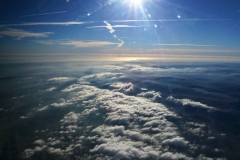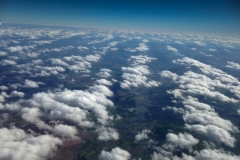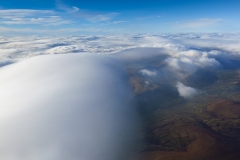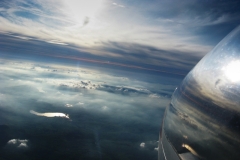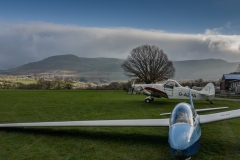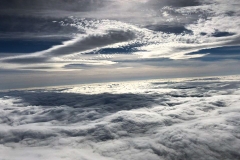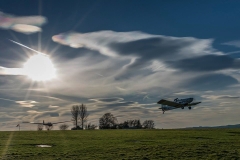Wave Flying
Some local information
We’ve mountains all around us, so wave can occur in almost any wind direction. The reliable conditions are probably only matched by Denbigh Gliding Club at Lleweni Park in North Wales.
Site record
The current site record is held by Tony Burton and stands at 32,000ft AMSL so forget all those long treks north of the border and come and try Talgarth Wave! Like soaring the Beacons, it is beyond the scope of these briefing notes to teach you wave flying. If you have not flown in wave before, you are strongly recommended to do some background reading before arrival.
A few points to remember
- Airway N864 runs over the top of the site at FL 125 with access to FL145 nearby so ensure that you are fully familiar where you can go and where you cannot. There is plenty of free airspace up to FL195 around us. Check the maps in the clubhouse if you are not sure.
- Remember that if you are sitting high and comfortable in wave, sunset will occur on the ground much earlier and you may be forced to land in the dark. Don’t get caught out! It can take a surprisingly long time to descend from high levels … the quickest way is to move to the “down” of the wave and open the brakes.
- Clear the ears frequently on the descent by chewing or you will experience a sharp pain, temporary deafness or worse. Never go wave flying with a head cold.
- If the wave is strong, you will experience tremendous rates of climb … and sink.
- Always be ready to descend if the wave slot shows signs of closing. If you do get caught out, in westerly wave, head downwind. The ground is lower, the air drier and the fields larger in England. Do not attempt a GPS descent through cloud without prior practice in clear air.
- When landing in an easterly when there is wave about, the approach can be very rough indeed but it usually smooths out near the ground.
The usual mountain waves at Talgarth are:
East to north east
In these winds, the primary wave can occur directly over the clubhouse and diamond heights are possible clear of the airway. The launch will be rough so be warned but it is well worth it to sit looking down at the Main Ridge above the clubhouse with the vario hard on the stops.
Often, we will launch you on to Mynydd Troedd (1,997amsl) to ridge soar until you can pick up the wave in the valley. Again, it can be rough, but pressing out into the valley usually gets you into the rotor which is the way up into the wave. We have seen this wave last for a full couple of days and enjoyed super flying when the rest of the UK was grounded.
North round to west
Being the prevailing wind, this is the most often encountered wave. It does not usually go much above 10 – 12,000ft but is easy to use and works over very large areas so cross countries are easy. Normally the wave is over the Wye Valley and can be reached from the Main Ridge. Towards the end of the day, it is often possible to sit at 5 or 6,000ft in front of the wave cloud looking down at the River Wye in the sunlit valley below. The views are out of this world and it is easy just to cruise north to Shobdon at min sink before a gentle return to the club.
South round to south west
This is the wind direction for the big climbs … the current club altitude record of 32,000ft is held by Tony Burton who made the climb over Madley in a strong south westerly. With the wind in the south, the Brecon Beacons can produce spectacular wave with the primary forming above Llangorse Lake …. once you’re settled in it, you can head west still in the primary for many miles.
With a south westerly, you can still soar the primary over Llangorse Lake but then, if conditions are right and you’re feeling good, drop right back towards the north east past the club, past Hay Bluff where the Black Mountains get in phase with the Beacons to form the really big wave over Madley Airfield (easily spotted thanks to the huge BT satellite dishes) in the Golden Valley. This is well clear of the airway and is the Talgarth Diamond Mine.
If you feel there is potential to climb higher than FL145 then we are able to open up ‘Wave Boxes’ that al;low us to fly with ATC approval up to FL195.
Procedure for using the Raglan/Madley Wave Boxes
1) Ring the Cardiff Duty Officer on 01446 712564, tell him what club you are from, and ask for both the Raglan and Madley wave boxes to be opened up to FL195 from a specified time allowing at least 30 mins for Cardiff to contact London ATC to get approval for the request. NB Usk GC may have already phoned and asked for the box to be opened. When you specify a start time give a generous allowance for pilots to reach the base of the wave box. It takes a long time to reach FL145 even in what you think are strong conditions.
2) Give them the call signs of all the gliders that may want to use the box. (They will ring back to confirm the airspace is “ours” from the start time requested for a two hour period).
3) In flight before you reach the box mentally note the QFE setting on your altimeter then set QNE.
4) Radio Cardiff on 119.150 MHz when you are about to enter the box. Use the correct radio procedure stating your current position, height and intentions.
5) Stay on 119.150 MHz whilst in the box and listen out as Cardiff may call you. Do not use this channel to chat to your mates as it is a commercial airband.
6) Keep strictly within the box and do not encroach into the airway. To know your position accurately you must have a moving map display with up-to-date airspace on it. Remember the wave boxes only go up to FL195.
7) Call Cardiff once you have descended out of the box and then change channels back to 118.685 MHz and reset your altimeter to QFE.
8) If all the gliders from our club have landed back please ring Cardiff again so that they can release the boxes earlier. (Make sure you tell them this applies to our gliders only. Usk may still have gliders in the box).
9) If you want the wave box to stay open for an additional two hours get someone on the ground to contact Cardiff Radar at least 30 minutes before the box is due to close to ask for an extension.
If you need to contact Usk GC, their number is 01291 690536

